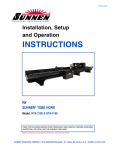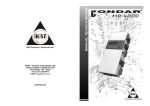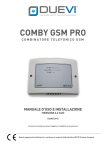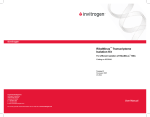Download Mir-X™ miRNA First-Strand Synthesis and SYBR qRT
Transcript
User Manual Mir-X™ miRNA First-Strand Synthesis and SYBR® qRT-PCR User Manual United States/Canada 800.662.2566 Asia Pacific +1.650.919.7300 Europe +33.(0)1.3904.6880 Japan +81.(0)77.543.6116 Clontech Laboratories, Inc. A Takara Bio Company 1290 Terra Bella Ave. Mountain View, CA 94043 Technical Support (US) E-mail: [email protected] www.clontech.com Catalog Nos. 638313, 638314, 638315 & 638316 PT4445-1 (PR033495) Published April 2010 Mir-X™ miRNA First-Strand Synthesis and SYBR® qRT-PCR User Manual Table of Contents I. Introduction.............................................................................................................................. 3 II. List of Components................................................................................................................. 4 III. Additional Materials Required................................................................................................ 4 IV. Polyadenylation and cDNA Synthesis.................................................................................... 5 A.Good PCR Practices ........................................................................................................................... 5 B.RNA Preparations Suitable for miRNA Analysis ................................................................................. 5 C.Protocol: DNase I Treatment of RNA (Optional)............................................................................... 5 D.Protocol: Polyadenylation and Reverse Transcription........................................................................... 6 V. Quantification of miRNA by qPCR.......................................................................................... 7 A. Choosing Your miRNA-Specific 5’-primer for qPCR........................................................................... 7 B.Protocol: Quantifying miRNA by qPCR............................................................................................. 7 VI. Data Analysis and Calculating miRNA Levels........................................................................ 8 A.Delta-Delta Ct Method . ..................................................................................................................... 8 B.Absolute Quantification Method (Standard Curve) ............................................................................ 8 VII.References................................................................................................................................ 9 List of Figures Figure 1. Mir-X miRNA qRT-PCR SYBR Kits use a single-step, single-tube reaction to produce first-strand cDNA, which is then specifically and quantitatively amplified using a miRNA-specific primer and SYBR Advantage qPCR chemistry.................................................................................................................... 3 List of Tables Table I: DNase I Reaction......................................................................................................................... 5 Table II: Poly(A)/cDNA Synthesis Reaction.............................................................................................. 6 Table III: Sample qPCR Reaction............................................................................................................. 7 Table IV: U6 qPCR Reaction................................................................................................................... 7 Table V: Sample Data for Delta-Delta Ct Calculation of miRNA Levels .................................................. 8 Protocol No. PT4445-1 www.clontech.com Version No. PR033495 2 Clontech Laboratories, Inc. A Takara Bio Company Mir-X™ miRNA First-Strand Synthesis and SYBR® qRT-PCR User Manual I. Introduction MicroRNAs (miRNAs) are members of a rapidly growing class of small non-coding RNAs, 19–23 nt in length, known to contribute to the regulation of gene expression in plants and animals. First discovered in C. elegans, miRNAs have been subsequently shown to be encoded in the genomes of higher vertebrates, including humans. miRNAs act on target mRNAs in a sequence-specific manner to either promote their cleavage and degradation or reduce their translational efficiency. The Mir-X miRNA qRT-PCR SYBR® Kit contains the components needed to quantify miRNAs (or other RNAs) isolated from any source. The Mir-X miRNA First-Strand Synthesis Kit (included in the Mir-X miRNA qRT-PCR SYBR Kit and also sold separately) is used for converting miRNAs, and other RNA molecules, into cDNA to enable specific RNAs to be quantified by real-time PCR (Figure 1). In a simple, single-tube reaction, RNA molecules are polyadenylated and reverse transcribed using poly(A) polymerase and our SMART™ MMLV Reverse Transcriptase; both of which are included in the mRQ Enzyme Mix. The SYBR® Advantage® qPCR Premix and mRQ 3’ Primer are then used in real-time qPCR, along with your miRNA-specific 5’ primer(s), to quantify specific miRNA sequences in the cDNA. Any other RNA species present in the original RNA sample, such as the mRNA targets of the miRNAs, can also be amplified and quantified using specific 5’ primers (1). The Mir-X miRNA kits are exceptionally easy to use and require minimal hands on time, making them perfect for high-throughput applications. Fewer manipulations means less chance of errors and highly reproducible results. The entire miRNA quantification procedure (cDNA synthesis and qPCR) can be completed within a half a day. First-strand cDNA synthesis from any RNA Add cDNA to miRNAspecific primers and SYBR Advantage Premix qPCR Data analysis Mir-X single-step cDNA synthesis 5' 3' Poly(A) polymerase 5' AAAAAAAAAAAAA-3' miRNA primer SYBR Advantage qPCR Oligo(dT) priming 5' AAAAAAAAAAAAA-3' NVTTTTTTTTTTTTT SYBR Advantage 5' 3' TTTTTTTTTTTTT 5' SMART MMLV RT 5' AAAAAAAAAAAAA-3' TTTTTTTTTTTTT 5' Figure 1. Mir-X miRNA qRT-PCR SYBR Kits use a single-step, single-tube reaction to produce first-strand cDNA, which is then specifically and quantitatively amplified using a miRNA-specific primer and SYBR Advantage qPCR chemistry. In the Mir-X cDNA synthesis reaction, RNAs are poly(A)-tailed using poly(A) polymerase, and then copied using a modified oligo(dT) primer and SMART MMLV Reverse Transcriptase. Clontech Laboratories, Inc. www.clontech.com A Takara Bio Company Protocol No. PT4445–1 Version No. PR033495 3 Mir-X™ miRNA First-Strand Synthesis and SYBR® qRT-PCR User Manual II. List of Components Store all components at –20°C. Mir-X miRNA First-Strand Synthesis Kit (20 rxn; Cat. No. 638313) • 25 µl mRQ Enzyme Mix • 100μl mRQ Buffer (2X) • 100µl mRQ 3’ Primer (10 µM) • 50μl U6 Forward Primer (10 µM) • 50μl U6 Reverse Primer (10 µM) • Mir-X™ miRNA First-Strand Synthesis and SYBR qRT-PCR User Manual (PT4445-1) Mir-X miRNA First-Strand Synthesis Kit (60 rxn; Cat. No. 638315) • 3 each Mir-X™ miRNA First-Strand Synthesis Kit (20 rxn; Cat. No. 638313) Mir-X miRNA qRT-PCR SYBR® Kit (200 rxn; Cat. No. 638314) • 1 each Mir-X miRNA First-Strand Synthesis Kit (20 rxn; Cat. No. 638313) –– 25 µl mRQ Enzyme Mix –– 100μl mRQ Buffer (2X) –– 100 µl mRQ 3’ Primer (10 µM) –– 50μl U6 Forward Primer (10 µM) –– 50μl U6 Reverse Primer (10 µM) –– Mir-X miRNA First-Strand Synthesis and SYBR qRT-PCR User Manual (PT4445-1) • 1 each SYBR® Advantage® qPCR Premix (200 rxn; Cat. No. 639676) –– 625 µl SYBR Advantage qPCR Premix (2X; 4 each) –– 100 μl ROX Reference Dye LSR (50X) –– 100μl ROX Reference Dye LMP (50X) –– SYBR Advantage qPCR Premix User Manual (PT3883-1) Mir-X miRNA qRT-PCR SYBR® Kit (600 rxn; Cat. No. 638316) • 3 each Mir-X miRNA First-Strand Synthesis Kit (20 rxn; Cat. No. 638313) • 3 each SYBR Advantage qPCR Premix (200 rxn; Cat. No. 639676) III. Additional Materials Required • Work areas and pipettors free of contaminating DNA, RNA, and nucleases • Cloned DNase I (RNase-free) (Takara Bio USA, Cat. No. TAK 2220A) [Optional] • Microfuge tubes, 0.2 ml, RNase-free • RNase-free water • Thermocycler, for incubating cDNA synthesis reactions • Real-time qPCR instrument (e.g. Stratagene Mx3000P®, or equivalent) Protocol No. PT4445-1 www.clontech.com Version No. PR033495 4 Clontech Laboratories, Inc. A Takara Bio Company Mir-X™ miRNA First-Strand Synthesis and SYBR® qRT-PCR User Manual IV. Polyadenylation and cDNA Synthesis Please read these protocols in their entirety before starting Successful results depend on performing the following steps correctly and in sequence. A. Good PCR Practices Because the cDNA produced by these protocols is intended to be used in qPCR analyses, due care must be taken to ensure that the samples and reagents are not contaminated with extraneous DNA from the laboratory environment. Due to the tremendous amplification power and sensitivity of qPCR, even trace amounts of contaminating DNA and RNA will be amplified and will affect Ct and final copy number values. Before you begin, prepare work areas free of potentially contaminating DNA, RNA, and nucleases. Ideally, assemble the cDNA synthesis reactions and dilute samples and controls in one work area with a dedicated set of pipettors. Assemble the qPCR reactions in a separate area or in a noncirculating containment hood using a different set of dedicated pipettors. Wear gloves at all times and use PCR pipette tips with hydrophobic filters, and dedicated solutions. We also recommend setting up negative template control (NTC) reactions lacking any template. Finally, perform all post-PCR analyses in a separate area, preferably in a separate room, with different pipettors. B. RNA Preparations Suitable for miRNA Analysis Because miRNAs are very small and not polyadenylated, not all RNA preparation methods will yield miRNAs. Acceptable sources of miRNAs include: premade total RNAs available from Clontech (e.g. any of our mouse tissue total RNAs); small RNA purified using the NucleoSpin® miRNA kit (Cat. Nos. 740971.10, 740971.50 & 740971.250); or total RNA purified using TRIzol® or other phenol-based methods. All of these miRNA preparations can be used for miRNA cDNA synthesis and qPCR. However, spin kits or columns used for total or poly(A)+ RNA isolation are not acceptable methods of preparing miRNA, as the small size of the RNAs allow them to pass through any column. Protocol 1 hr C. Protocol: DNase I Treatment of RNA (Optional) If your RNA sample was prepared from transfected cells, or contains trace amounts of plasmid or significant amounts of genomic DNA, the RNA should be treated with DNase I to reduce or eliminate background signal in subsequent qPCR applications. This is especially important if the miRNA of interest was expressed from a transfected plasmid or a viral vector. Contaminating DNA fragments that contain your miRNA sequence will be amplified in control reactions lacking reverse transcriptase (No RT controls), which can lead to inaccurate qPCR results. For analyses of endogenous miRNAs, DNase I treatment may not be needed. 1. Cloned DNase I (RNase-free) is available from Takara Bio USA (Cat. No. TAK 2220A). 2. In a 0.2 ml RNase-free tube, combine the following: Table I: DNase I Reaction Reagent RNA sample (3.5–10 µg) Volume (µl) ≤ 44 DNase I Buffer (10x) 5 DNase I (2 U/µl) 1 RNase-free ddH2O Total volume 44–[RNA µl] 50 3. In a thermocycler, incubate 30 min at 37°C, then inactivate the DNase I by heating to 75°C for 5 min. 4. The DNase I-treated RNA can be used directly in the Polyadenylation and Reverse Transcription Protocol (Section D). Clontech Laboratories, Inc. www.clontech.com A Takara Bio Company Protocol No. PT4445–1 Version No. PR033495 5 Mir-X™ miRNA First-Strand Synthesis and SYBR® qRT-PCR User Manual IV. Polyadenylation and cDNA Synthesis continued Protocol 1 hr D. Protocol: Polyadenylation and Reverse Transcription Prepare a cDNA synthesis reaction for each RNA sample you wish to analyze by qPCR. In addition, if you plan to determine the absolute level of an miRNA using a standard curve, you will need to generate cDNA from dilutions prepared from a known concentration of synthetic miRNA. 1. In an RNase-free 0.2 ml tube, combine the following reagents: Table II: Poly(A)/cDNA Synthesis Reaction Reagent mRQ Buffer (2x) Volume (µl) 5 RNA sample (0.25–8 µg) 3.75 mRQ Enzyme 1.25 Total volume 10 2. Preferably in a thermocycler, incubate the tube for 1 hour at 37°C, then terminate at 85°C for 5 min to inactivate the enzymes. 3. Add 90 µl ddH2O to bring the total volume to 100 µl. 4. Your cDNA is now ready for the miRNA quantification protocols in Section V. Protocol No. PT4445-1 www.clontech.com Version No. PR033495 6 Clontech Laboratories, Inc. A Takara Bio Company Mir-X™ miRNA First-Strand Synthesis and SYBR® qRT-PCR User Manual V. Quantification of miRNA by qPCR Before performing qPCR, determine the quantification method to be used for the samples you wish to analyze. We suggest using either a comparative Ct method (e.g. the delta-delta Ct method or ddCt), or an absolute quantification method that entails constructing a standard curve. Each of these methods requires performing additional qPCR amplifications: U6 snRNA controls for the ddCt method, or cDNA prepared from synthetic miRNA for the standard curve method, and are described briefly in Section VI. For additional information regarding the set-up of qPCR reactions using the SYBR Advantage qPCR Premix, including instrument-specific instructions, consult the SYBR Advantage qPCR Premix User Manual (PT3883-1). A. Choosing Your miRNA-Specific 5’-primer for qPCR We recommend that the entire sequence of your mature miRNA (21–23 nt) be used as your miRNA-specific, 5’ primer. The 3’ primer for qPCR is the mRQ 3’ Primer supplied with the kit. note: The miRBase Sequence Database is a searchable database of miRNA sequences, maintained by the University of Manchester at: http://www.mirbase.org B. Protocol: Quantifying miRNA by qPCR For miRNA quantification, we recommend using the delta-delta Ct method to determine the level of each miRNA relative to the level of U6 snRNA. For this method, you will need to perform a qPCR amplification of U6 for each cDNA sample you wish to analyze. Alternatively, absolute quantification can be performed by using the Ct value(s) obtained for the miRNA in the unknown sample (or sample dilution) to obtain copy number values from a Ct vs copy number standard curve that is generated from cDNA synthesized from tenfold serial dilutions of a known concentration of synthetic miRNA. 1. Perform all sample, U6, and standard curve reactions in duplicate. Be sure to include appropriate no template controls (NTC) for each primer set. For each reaction, combine the following reagents: Table III: Sample qPCR Reaction Reagent ddH2O Volume (µl) 9 Table IV: U6 qPCR Reaction Reagent ddH2O Volume (µl) 9 SYBR Advantage Premix (2X) 12.5 SYBR Advantage Premix (2X) 12.5 ROX Dye (50X) 0.5 ROX Dye (50X) 0.5 miRNA-specific Primer (10 µM) 0.5 U6 Forward Primer (10 µM) 0.5 mRQ 3’ Primer 0.5 U6 Reverse Primer (10 µM) 0.5 cDNA 2.0 cDNA 2.0 Total volume 25 Total volume 25 2. Cycle the reactions according to the instructions provided by the manufacturer of your real-time qPCR instrument. We routinely use the following conditions with the Stratagene Mx3000P instrument: • Denaturation –– 95°C 10 sec • qPCR x 40 Cycles –– 95°C 5 sec –– 60°C 20 sec • Dissociation Curve –– 95°C 60 sec –– 55°C 30 sec –– 95°C 30 sec Clontech Laboratories, Inc. www.clontech.com A Takara Bio Company Protocol No. PT4445–1 Version No. PR033495 7 Mir-X™ miRNA First-Strand Synthesis and SYBR® qRT-PCR User Manual VI. Data Analysis and Calculating miRNA Levels The two quantification approaches cited here are described only very briefly. For detailed explanations of these and other qPCR strategies, consult a comprehensive qPCR reference. For additional information regarding the set-up of qPCR reactions using the SYBR Advantage qPCR Premix, including instrument-specific instructions, consult the SYBR Advantage qPCR Premix User Manual (PT3883-1). A. Delta-Delta Ct Method The delta-delta Ct method (ddCt) is an approximation method that measures the relative levels of a miRNA between two samples by comparing them to a second RNA which serves as a normalization standard (e.g. U6). Briefly, the unknown miRNA and the U6 RNA are amplified in each sample to determine the Ct for each. This allows relative levels to be determined using the ddCt calculation. An example is shown below: Table V: Sample Data for Delta-Delta Ct Calculation of miRNA Levels Ct(miR-122a) Ct(U6) dCt Brain Sample RNA 30 25 5 Liver 20 24 –4 Calculating relative copy numbers using the delta-delta Ct method: [miR-122a]Liver/[miR-122a]Brain: 2–dCt(Liver) / 2–dCt(Brain) = 2–(–4) / 2–(5) = 29 = 512* *This result indicates that the level of miR-122a is 512-fold higher in the liver than in the brain. Theoretically, between successive PCR cycles (i.e., each delta Ct ) there is a twofold difference in PCR product. In this case, a normalized Ct difference of 9 between the samples gives 29, which is 512-fold. Important: a number of assumptions need to be considered before this method can be used correctly. The relative levels of the U6 should not differ between samples. More importantly, the amplification efficiency of the primers should be near 100% (i.e., the amount of product should actually increase twofold with each PCR cycle). If primer efficiency is significantly less than 100%, then this method will not be accurate and either the primers should be redesigned or the absolute quantification method should be used (Section B). B. Absolute Quantification Method (Standard Curve) In this method, a calibrated preparation of synthetic miRNA is used to make serial dilutions and generate the standard curve. The plot then used to determine miRNA copy number from the Ct values obtained from the experiment samples. 1. Determine the average Ct values for the duplicate qPCR reactions of the cDNA samples generated from the diluted synthetic miRNA samples, and plot these Ct values vs. input miRNA copy number on a log scale. 2. Determine average Ct values for each duplicate experiment sample, or sample dilution, and extrapolate the corresponding RNA copy number from these Ct values using the standard curve generated in Step 1. Use all Ct values that are below that of the NTC. Protocol No. PT4445-1 www.clontech.com Version No. PR033495 8 Clontech Laboratories, Inc. A Takara Bio Company Mir-X™ miRNA First-Strand Synthesis and SYBR® qRT-PCR User Manual VII. References 1. Mir-X™ MicroRNA Quantification (2009) Clontechniques XXIV(2):4–5. Notice to Purchaser Clontech products are to be used for research purposes only. They may not be used for any other purpose, including, but not limited to, use in drugs, in vitro diagnostic purposes, therapeutics, or in humans. Clontech products may not be transferred to third parties, resold, modified for resale, or used to manufacture commercial products or to provide a service to third parties without written approval of Clontech Laboratories, Inc. PCR NOTICE TO PURCHASER: LIMITED LICENSE Use of this product is covered by one or more of the following US patents and corresponding patent claims outside the US: 5,079,352 and 6,127,155. The purchase of this product includes a limited, non-transferable immunity from suit under the foregoing patent claims for using only this amount of product for the purchaser’s own internal research. No right under any other patent claim (such as method claims in U.S. Patents Nos. 5,210,015, 5,487,972, 5,994,056 and 6,171,785) and no right to perform commercial services of any kind, including without limitation reporting the results of purchaser's activities for a fee or other commercial consideration, is hereby conveyed by the purchase of this product expressly, by implication, or by estoppel. This product is for research use only. Diagnostic uses require a separate license from Roche. Further information on purchasing licenses may be obtained by contacting the Director of Licensing, Applied Biosystems, 850 Lincoln Centre Drive, Foster City, California 94404, USA. SYBR This product is provided under an agreement between Molecular Probes, Inc. and Clontech and the manufacture, use, sale or import of this product is subject to one or more of U.S. Patent Nos. 5,436,134; 5,658,751 and corresponding international equivalents, owned by Invitrogen Corp. The purchase of this product conveys to the buyer the nontransferable right to use the purchased amount of the product and components of the product in research conducted by the buyer, where such research does not include testing, analysis or screening services for any third party in return for compensation on a per test basis. The buyer cannot sell or otherwise transfer (a) this product (b) its components or (c) materials made using this product or its components to a third party or otherwise use this product or its components or materials made using this product or its components for Commercial Purposes. Commercial Purposes means any activity by a party for consideration and may include, but is not limited to: (1) use of the product or its components in manufacturing; (2) use of the product or its components to provide a service, information, or data; (3) use of the product or its components for therapeutic, diagnostic or prophylactic purposes; or (4) resale of the product or its components, whether or not such product or its components are resold for use in research. For information on purchasing a license to this product for purposes other than research, contact Molecular Probes, Inc., Business Development, 29851 Willow Creek Road, Eugene, OR 97402. Tel: 541.465.8300, Fax: 541.335.0354. U.S. Patent No. 5,436,149 for LA Technology is owned by Takara Bio Inc. TaqStart® and other Hot Start Antibodies are licensed under U.S. Patent No. 5,338,671. SYBR® is a registered trademark of Molecular Probes, Inc. TRIzol® is a registered trademark of Invitrogen, Inc. Clontech, the Clontech Logo and all other trademarks are property of Clontech Laboratories, Inc., unless noted otherwise. Clontech is a Takara Bio Company. ©2010 Clontech Laboratories, Inc. Clontech Laboratories, Inc. www.clontech.com A Takara Bio Company Protocol No. PT4445–1 Version No. PR033495 9















![[ITA] COMBY GSM-PRO Manuale v1-6](http://vs1.manualzilla.com/store/data/006121284_1-5ab7538fa8309621ea3d94ebc51eae23-150x150.png)

